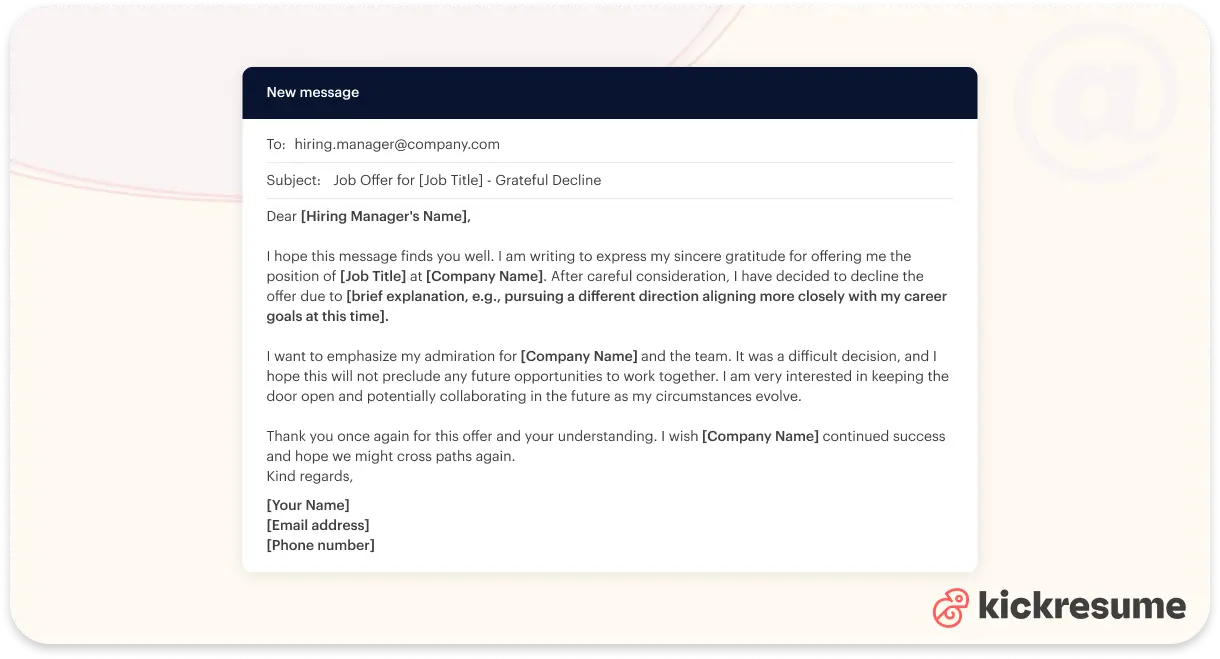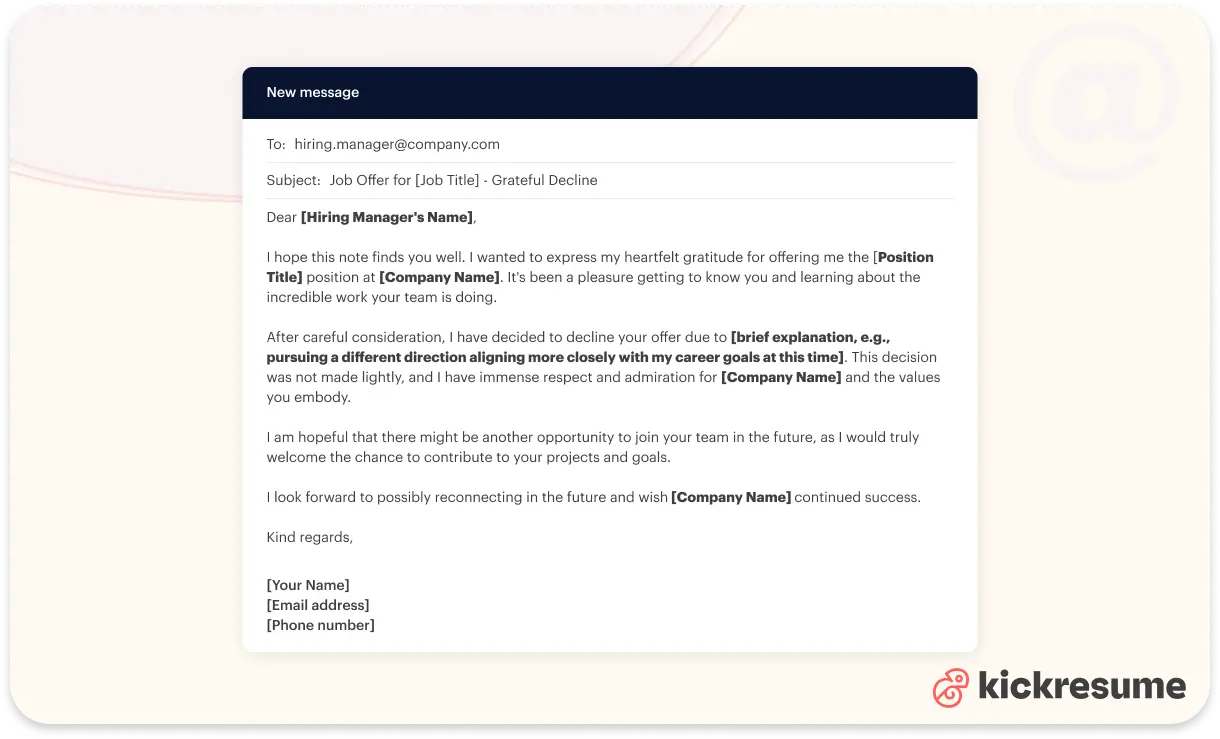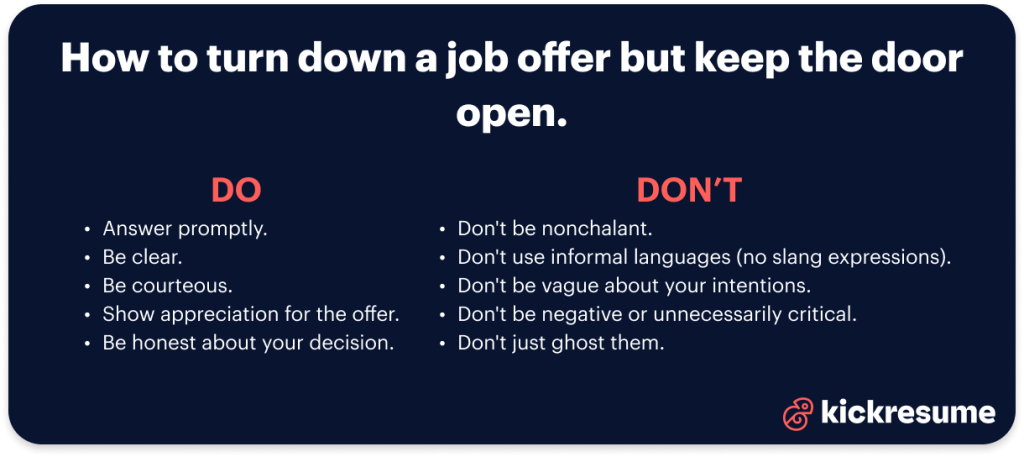Figuring out how to turn down a job offer but keep the door open for potential future opportunities can feel like walking a tightrope.
Still, the ability to graciously decline an offer without burning any bridges is invaluable for all professionals.
The problem is: How can you possibly communicate your decision in a way that allows you to maintain a good relationship with the would-be employer?
The key lies in crafting a response that is both respectful and sincere. Moreover, one that clearly shows your appreciation for the offer, but remains clear about your current decision.
Read on and find out:
- Why you should never burn bridges;
- How to write a polite rejection email step-by-step;
- 5 email templates you can copy&paste;
- And, our tips on how to stay in touch after declining a job offer.
- Why you should never burn bridges
- How to turn down a job offer but keep the door open via email
- How to turn down a job offer but keep the door open (email samples)
- How absolutely NOT to respond
- How to stay in touch with an employer you rejected?
- Key takeaways: How to turn down a job offer but keep the door open
Why you should never burn bridges
You might be asking yourself: what's the point of keeping up good relationships with employers whose job offer I'm declining anyways?
While you may have valid reasons for turning down a job offer (such as inadequate salary, unsuitable cultural fit, distance, getting a better offer, etc.) make sure you never fully close the door behind you.
Always remember one thing – the professional world thrives on relationships.
Each and every professional interaction is an opportunity to build your reputation, expand your network, and open up future career possibilities.
And, how you handle refusing a job offer may have a long-term impact on your career:
- Access to future opportunities. The professional landscape is relatively small. By keeping doors open, you make room for future job opportunities that may be a better fit. After all, the same employer could offer you a more suitable position later.
- Expanding your professional network. Similarly, a positive relationship with an employer can lead to recommendations, referrals, and valuable references within your industry.
- Influencing your professional reputation. Again, you'd be surprised how small some industry circles can be. Rejecting job offers with grace and professionalism ensures you're remembered positively. Word of the mouth spreads fast, and mishandling delicate situations can influence your industry standing.
How to turn down a job offer but keep the door open via email
Even though it might seem like a Herculean task, composing a truly impactful job rejection email doesn't have to be complicated.
Of course, there are a few principles you should always follow.
For once, let's remember that any professional email belongs under the umbrella of formal writing. This means that the way it's structured follows a certain given logic.
So, your job offer rejection email should consist of these 7 components:
- Clear subject line
- Appropriate salutation
- Expression of gratitude
- Decision statement
- Interest in future interactions
- Sign off
- Contact information
#1 Clear subject line
If you don't announce the purpose of your email directly in its subject line, chances are it can get overlooked and then lost somewhere in the multitudes received daily by the recruiters.
This is how a clear an professional subject line can look like:
- Job Offer Decline - [Your Name]
- Job Offer Decline - [Job ID number] - [Your Name]
- Job Offer for [Job Title] - Grateful Decline
#2 Appropriate salutation
At this point, you've already met the hiring manager/recruiter in person at least once during a job interview. Therefore, you absolutely have to address them by their name.
If you start your email by “Dear hiring manager,” it can come across as:
- A sign of lacking professionalism. Having already met face-to-face, a certain level of familiarity has been established between you two. So be courteous and acknowledge this by getting their name right.
- Your disinterest. They might think that you simply don't care. This negligence can endanger your goals - you're trying to stay on their good side, right?
#3 Expression of gratitude
You want to start your very first paragraph by expressing your sincere thanks for the job offer and the opportunity to learn about the company and the team. You can show your appreciation in 3 ways:
- Thank them for the opportunity
- Highlight specific aspects of the process
- Express your respect for the company
#4 Decision statement
Rejections aren't pleasant, not even for big corporations. Consequently, many can end in one side cutting off the other. Hence, you want to articulate the decision politely, be "nice", and be clear.
- Mention it was not an easy decision, showing careful consideration.
- Be clear and direct to prevent misunderstandings or hopes of negotiation.
- Offer a professional, generic reason related to job fit or career goals.
#5 Interest in future interactions
The final paragraph of your rejection email should be dedicated to:
- Reiterating your praise of the company;
- Expressing your desire to keep the communication channel between yourself and the employer going.
For example: "While I must decline the offer at this time, I would like to remain in contact and explore any future possibilities that might emerge. I believe strongly in the work your company does and would love the chance to contribute in the future."
#6 Professional sign off
Every formal letter, paper or electronic, calls for a proper sign off. You can use any of the following phrases:
- Kind regards,
- Best wishes,
- Yours sincerely,
- Respectfully,
#7 Contact information
Lastly, place your contact details right after your sign off. Make sure to include:
- Your name
- Email address
- Phone number
How to turn down a job offer but keep the door open (email samples)
Now, let's put all of these elements together and have a look at 6 job offer rejection emails.
Feel free to use them as your first drafts – Either press the download button on the first three samples, or just copy the text of the email samples below and simply adjust it to your liking.
#1 Formal job rejection email sample

#2 Short and sweet job rejection email sample

#3 Warm and personal job rejection email sample

How absolutely NOT to respond
This example is really just an opportunity for us to present a checklist of what you should never EVER write into your job offer rejection email:
- Don't be rude or disrespectful.
- Don't be nonchalant.
- Don't use informal languages (no slang expressions).
- Don't be vague about your intentions.
- Don't be negative or unnecessarily critical.
- Don't just ghost them.
How to stay in touch with an employer you rejected?
Finally, once you've sent your email, the ball's in your court.
Don't forget, it's your responsibility to keep the door cracked open.
In order to keep in touch with the employer you've rejected, you can:
- Follow them on social platforms;
- Connect with them on LinkedIn;
- Sign up for their newsletter;
- Attend industry events.
All of the above will ensure that you stay updated on the company's activities, projects and new employment possibilities.
Apart from engaging with the company's content, you can also ask the hiring manager for an informational interview and learn more about the employer and any possible work opportunities.

Key takeaways: How to turn down a job offer but keep the door open
The way you communicate your decision can significantly impact your professional reputation and future opportunities.
To keep the door open even after a job offer rejection, your response should be:
- respectful,
- sincere,
- clear,
- showing appreciation for the offer while being honest about your decision.
Lastly, these 7 steps will instruct you on how to turn down a job offer but keep the door open:
- Write a specific subject line.
- Address the hiring manager/recruiter by their name.
- Start by expressing your gratitude.
- State your decision.
- Show interest in future interactions.
- Sign off appropriately.
- Include your contact information.



